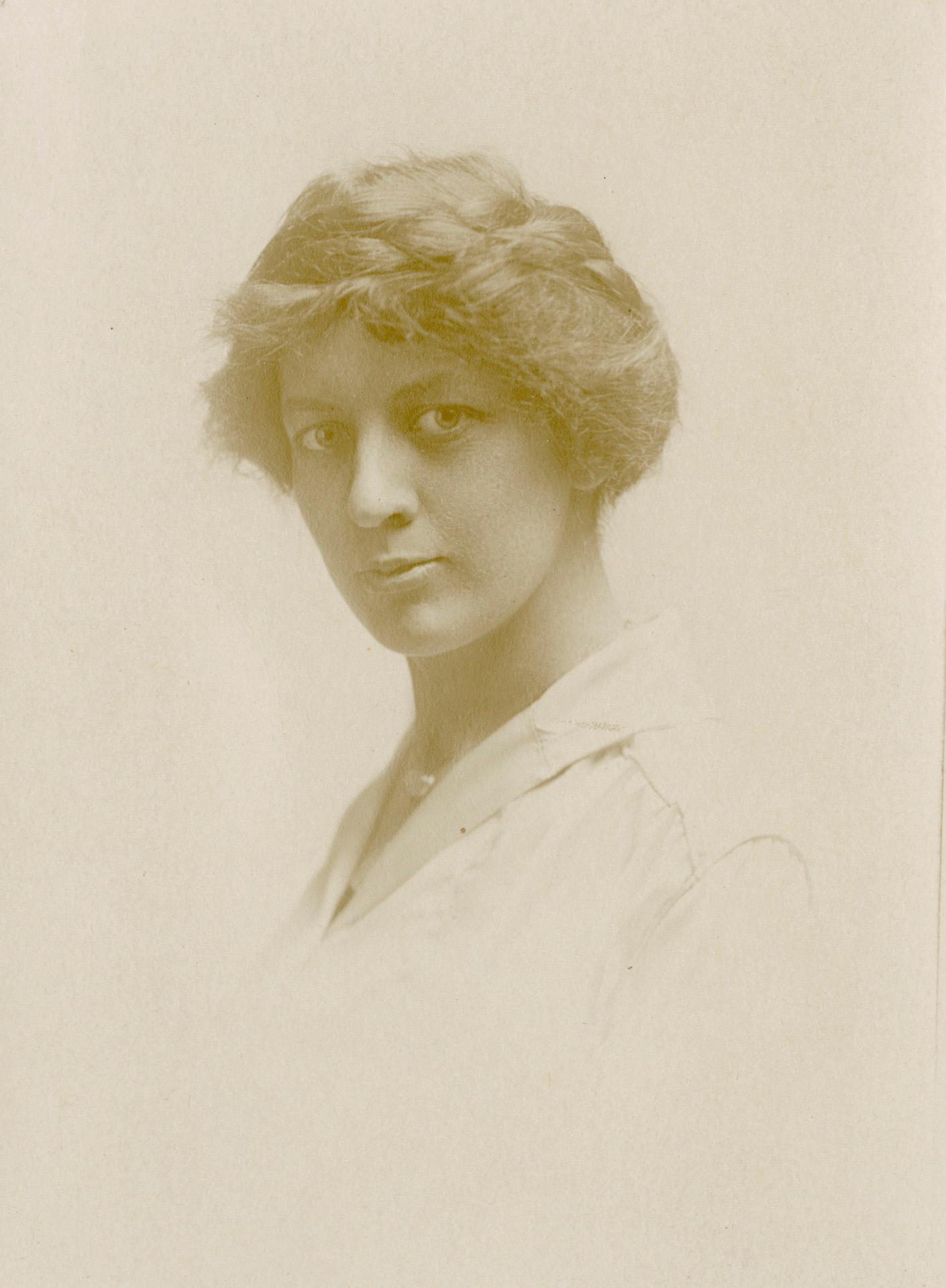Lillian Helena Smith, librarian, educator, writer, literacy advocate (born 17 March 1887 in London, ON; died 5 January 1983 in Toronto, ON). Lillian Smith was the first certified children’s librarian in the British Empire. She pioneered and developed children’s services in the Toronto library system, setting standards that became influential worldwide. She introduced a dedicated classification system for children’s libraries, promoted reading in schools and served on the American Library Association as well as Canadian librarian’s associations. (See also Children’s Literature in English and Children’s Literature in French.)
This article was created in collaboration with The Museum of Toronto.

Childhood and Education
Lillian H. Smith grew up in London, Ontario, the youngest of four children of British immigrant parents. Her mother, Elizabeth Smith (née Rosevear), was an organist and pianist; her father, John Vipond Smith, was a Methodist minister. He let Lillian peruse his library, and she became a passionate reader at a young age.
After graduating from Victoria College, University of Toronto, in 1910, Smith came across an article about the training school for children’s librarians at the Carnegie Library in Pittsburgh, Pennsylvania. In Canada, there was no dedicated training for children’s librarians at the time, and space for children and children’s books in libraries was minimal. Carnegie Library was the first American public library with a specialized children’s department and the only one with a training program. Smith applied successfully. Upon completion of the one-year course, she accepted a job offer from the New York Public Library, where she was quickly put in charge of the children’s room at the Washington Heights Branch. Her supervisor was pioneer children’s librarian Anne Carroll Moore, who became a close friend.
According to an anecdote Smith told later, she managed to quiet down a group of noisy, misbehaving boys in the Washington Heights children’s room by reading from Tom Sawyer. This choice drew moral objection from a conservative coworker because of the protagonist’s lying.
Building Children’s Library Services in Toronto
After about a year in New York, Lillian Smith was contacted by Toronto Public Library (TPL) Chief Librarian George Locke. He was planning to establish a children’s department and offered Smith a leading role. Smith returned to Toronto in the summer of 1912 and became the first head of the TPL children’s department, a position she would hold for 40 years. She was the first professionally trained children’s librarian in the British Empire.
Smith started at the Central Library (opened in 1909 at College and St. George Streets), which had a small children’s room with a disorganized selection of donated books. She quickly set out to expand and improve the collection. Rather than following traditional guidelines (e.g., from churches), Smith rejected moralizing or propagandistic stories for children and instead selected books according to their “usefulness in actual experience with the reading interests of boys and girls.” Such books, she thought, would appeal to children from all social backgrounds and, in particular, provide children from “bookless homes” with stepping stones into the literary world.
Smith also organized activities for young readers such as story hours and introduced training for new staff. In 1913, she planned the first dedicated children’s department in the TPL’s new Dovercourt branch, now named Bloor/Gladstone branch. Children’s rooms in other branches followed.
Smith promoted children’s literacy beyond the library as well, by involving teachers and parents, visiting classrooms and working with schools to start their own libraries. She opened the first school library — another first in Canada — in 1926.
Boys and Girls House
The TPL children’s rooms and departments became increasingly popular. Circulation almost doubled between 1912 and 1920, and especially in the Central branch, overcrowding became an issue; children often had to be turned away for lack of space. This situation prompted the founding of a new library branch exclusively dedicated to children’s books. TPL purchased a residential home near the Central Library (40 St. George St.), and in September 1922, the new “Boys and Girls House” opened to the public. It was the first children’s library in the British Commonwealth.
The Boys and Girls House contained several rooms for children to read and check out books, administrative offices and a collection of librarianship resources. A theatre was added in 1928. Lillian Smith encouraged her staff to practice play reading, storytelling, puppetry and folk dance, and she programmed story hours, reading clubs, theatre and puppetry productions and debates. Within the first year of operation, the new library was so popular that its main circulation room was standing room only.
With its innovative, engaging program and its study facility for professionals, the Boys and Girls House also served as an important resource for educators, librarians and others working with children. It soon evolved into a centre for the children’s library movement and the study of children’s literature. The Boys and Girls House promoted and influenced children’s literacy far beyond the library itself — e.g., through CBC radio programs — and became one of the most renowned children’s libraries in the world.
Structural issues made it necessary to demolish the building in 1963, and a new, larger one opened at the same location a year later. In 1995, the collections of the Boys and Girls House were moved to the new College Street branch of the TPL, which was named the Lillian H. Smith Branch.
Classification System for Children’s Libraries
In 1930, Lillian Smith and her coworkers developed a classification system specifically for children’s libraries, since they found the Dewey decimal system used by TPL unsuitable for children’s literature and unintuitive to children. The new system, soon known as the Lillian H. Smith classification, reflected the order in which children advance in their reading and consisted of letters rather than numerical codes.
The system was introduced to the TPL children’s libraries in the summer of 1930 and was found to have a positive impact on circulation. It remained in use until the 1990s, when the TPL reverted to the Dewey system, although mainly for reasons of uniformity in cataloguing. However, parts of Smith’s system are still being used today.

The Osborne Collection and Lillian H. Smith Collection
In 1934, Lillian Smith received a visit from Edgar Osborne, an English librarian and book collector. He and his wife had assembled a collection of rare and historical children’s books, some dating back to the 16th century. They were impressed by Smith’s achievements at the Boys and Girls House, and the idea arose to make the TPL a permanent home for their collection. In 1949, after his wife’s death, Osborne donated about 2,000 books to the TPL Board as a memorial to his wife and tribute to Smith.
The Osborne Collection was kept in the Boys and Girls House and carefully maintained and extended. At present it comprises over 80,000 items, with the oldest from the 14th century and a cut-off point in the year 1910. In 1962, the collection was amended with a separate selection of notable, more recent English-language children’s books published after 1910 named the Lillian H. Smith Collection. Today, both collections are stored at the Lillian H. Smith Branch of the TPL, with selected items on display.
Teaching, Writing and Advocacy
Smith was a tireless educator for children’s librarians, not only in the library but also in higher education. From 1913 to 1952, she taught at the Provincial Library Training School, which was integrated into the University of Toronto in 1928. Her student Sheila Egoff, who trained in the 1930s and later became Canada’s first professor of children’s literature, remembers Smith’s “deep knowledge of literature and an infectious enthusiasm for children’s librarianship.” She describes Smith’s teaching as “captivating” and “inspirational.” At the Boys and Girls House, Smith regularly invited other librarians, children’s editors and writers as guest educators for staff meetings, including her mentor and friend Anne Carroll Moore.
In her writing, which comprises numerous articles and two books, Smith laid the groundwork for children’s librarianship of the 20th century. In 1927, she edited the first (and, in 1940, the second) edition of Books for Boys and Girls, a reading guide for children’s libraries that became a standard in many English-speaking countries. Her critical work The Unreluctant Years, published in 1953, details her philosophy of providing children with books of high quality: “only the books worthy of them, the books of honesty, integrity, and vision — the books on which they can grow.”
An engaging leader and networker, Smith brought together a community of children’s librarians and others working with children. In 1920, she held a Boys and Girls Work Congress to connect organizations in this field, with speakers from New York and Brooklyn. Smith was also active in the Ontario Library Association (OLA); meetings of its children’s section took place in the Boys and Girls House for some time. She served as the OLA’s president in 1928–29 and was a member of the American Library Association’s (ALA) Executive Board from 1932 to 1936. In 1939, she was involved in the foundation of the Canadian Association of Children’s Librarians (CACL), which predated the founding of the Canadian Library Association (1946).
Legacy
Lillian Smith was a pioneer in many ways. As the first children’s librarian in Canada, she established the first Canadian children’s library in the city of Toronto. When she retired in 1952, children’s library services were available in 16 branch libraries, 30 schools, two settlement houses (accommodations for new immigrants and people affected by poverty) and the Hospital for Sick Children. As a literary critic, Smith also defined standards for children’s literature. Her book lists and reading guides for children’s libraries are still influential today.
TPL’s Lillian H. Smith Branch on College Street, which houses the Lillian H. Smith and Osborne Collections, is not only named after her but also honours her legacy. It continues much of the programming she introduced to the original Boys and Girls House such as story hours and puppetry.
Smith was convinced that every child should have access to good books, regardless of physical or mental ability and social, ethnic or cultural background. This inclusive philosophy motivated her to establish libraries in children’s hospitals, community centres, schools in disadvantaged neighbourhoods without a local public library and schools for children with special needs. The role of the children’s librarian, in her words, should be to deliver “the right book, to the right child, at the right time.”
Honours and Awards
- Clarence Day Award, American Library Association (1962)
- Lillian H. Smith Collection, book collection, Toronto Public Library (est. 1962)
- Lillian H. Smith Branch, branch library maintaining the collections and programming of the Boys and Girls House, Toronto Public Library (est. 1995)

 Share on Facebook
Share on Facebook Share on X
Share on X Share by Email
Share by Email Share on Google Classroom
Share on Google Classroom




